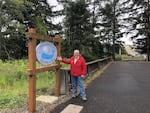The exploding whale is a piece of Oregon lore that just won’t go away. It’s one of those real-life stories that just sounds too strange to be real. But it most definitely happened and retired Oregon Coast reporter Larry Bacon was there.

Larry Bacon, 79, was a new reporter at The Register-Guard on that fateful day in 1970 when Oregon highway officials blew up a rotting sperm whale on a beach near Florence, Ore.
Courtesy of Larry Bacon
“It was an exciting day for me because I was a new reporter for The Register-Guard,” Bacon said. “I had probably [worked there] about a month, and it was an exciting story.”
Here are the basic facts: On Nov. 9, 1970, a 45-foot, 8-ton dead sperm whale washed up on the shore of the coastal town of Florence, Oregon. It was huge. It was stinky. And it needed to be gone yesterday.
Back then the coast was managed by the State Highway Division, and agency officials figured the best way to get rid of the immovable mammal was by blowing it up with half a ton of dynamite. The thought was those highway officials would remove the whale the same way they removed any other large obstruction, Bacon said.
“They were going to remove it like it was a big boulder on the highway,” Bacon said. “They were going to blow the whale to pieces, out toward the sea, and the fish and seagulls would eat most of it.”
That plan was a spectacular failure. And it didn’t help that highway engineers didn't provide a countdown before detonation on the afternoon of Thursday, Nov. 12, 1970, said Bacon.
“All of a sudden there was this hundred-foot geyser of blood, blubber and sand going up into the sky,” Bacon said. “It was like a blubber snowstorm with tiny particles of blubber floating down after the big chunks.”
Bacon said the few dozen spectators and reporters who came to watch the blast from what they thought was a safe quarter-mile distance away began screaming and running away. But how do you run away from stinky, blubber rain?
Related: What do you find curious about the Northwest? Share it with us
Luckily no one reported any explosion-related injuries, but one car did get its roof smashed in by a three-foot chunk of whale that fell from the sky. Bacon’s car was parked next to it.
The worst part, according to Bacon, was the smell. It lingered with the onlookers for days.
“People were retching,” Bacon said. “It stuck to your clothes and everything.”
What might be the hardest part to believe in this story is that the engineer behind the blast, George Thornton, thought the effort was a success.
“It was kind of funny because I interviewed him afterward, and he said it went exactly right,” Bacon said. “Except, the dynamite cases funneled down into the sand and directed the explosion straight up.”
It’s safe to say that state officials learned their lesson from this historic event. State policy now is to bury, not blow up, dead whales that end up on the beach.
The legend of flying whale bits is an enduring one. That's thanks, in part, to the journalists like Bacon who first reported the story. And the internet, of course. Plus, the fine folks of Florence voted last year to commemorate the whole thing by naming its newest seaside park after the explosion. (It's open now, and you can enjoy a picnic while contemplating exploding whales there.)

Florence, Ore., Mayor Joe Henry poses in front of the sign welcoming visitors to the Exploding Whale Memorial Park. The park is named in honor of the 1970 explosion of a rotting sperm whale on the Oregon Coast just outside of the city's limits.
Megan Messmer / City of Florence
But, in Bacon’s opinion, this story continues to live on for one reason: It is just so unbelievably bizarre.



